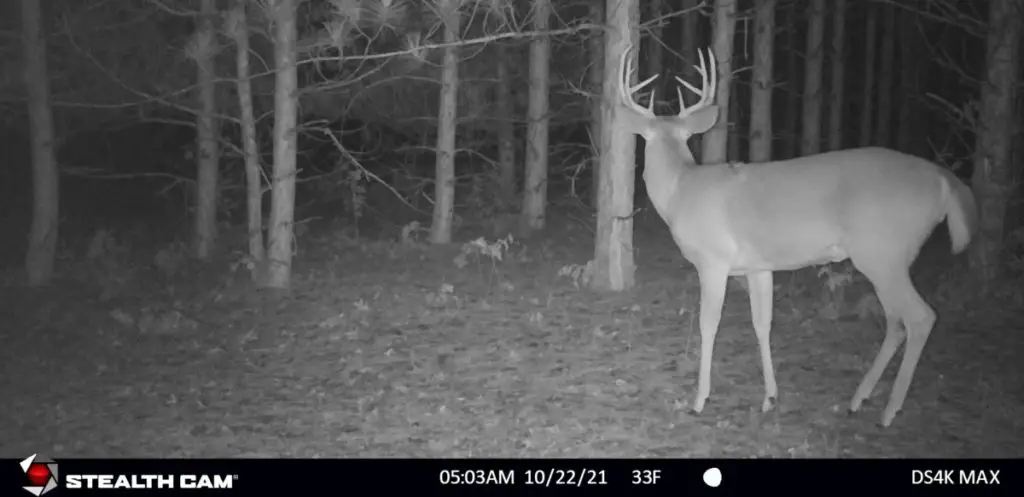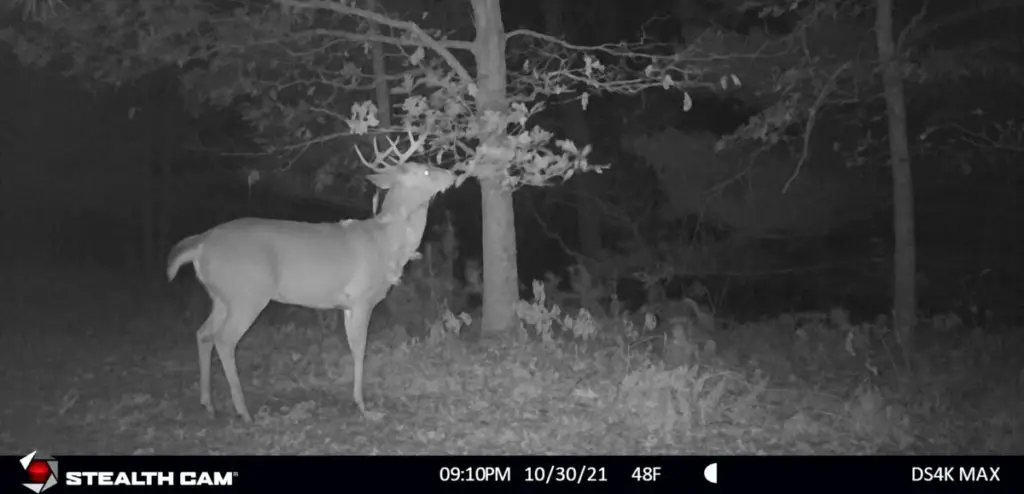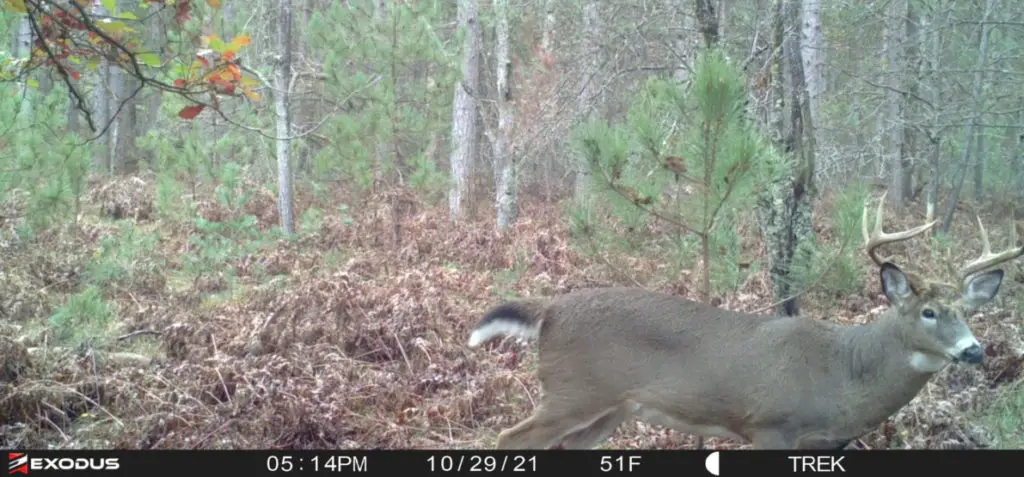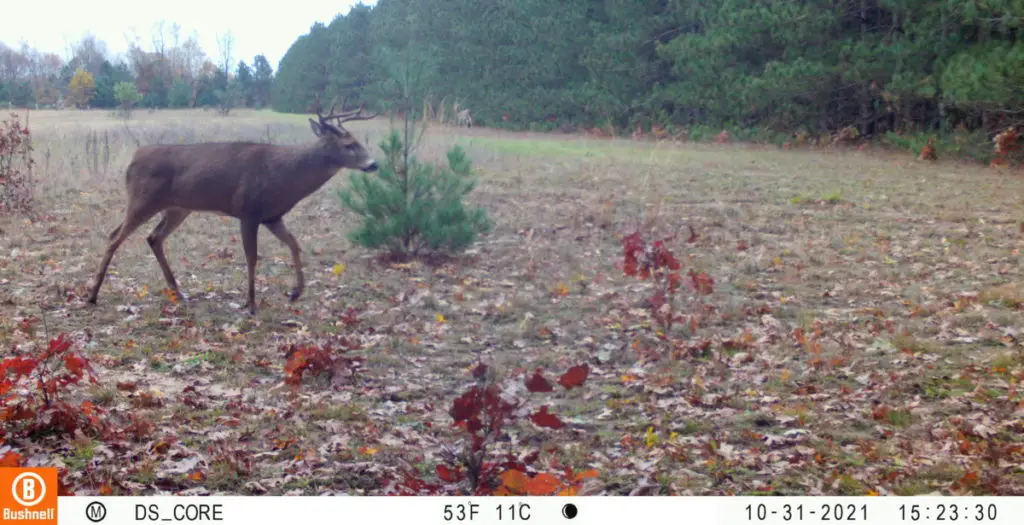It is inevitable at some point in your life you have heard someone refer to the moon phase affecting deer movement. It is plausible right? I mean the gravitational pull of the moon affects simple things like the high and low tides of the ocean, why wouldn’t it have an affect on other things in the natural world.
You can easily find people on both sides of the argument, from very successful hunters (who are far more successful than I am) who claim they only hunt moon phases, to scientific studies such as this one from Penn State University, that claims there are no significant movements based on moon phase.
For the average person, such as myself, it is hard to know what to believe. Do I believe those who are successful hunters year in and out, or do I follow the scientific evidence of those who spend their professional working careers tracking such things?
So, I created my own experiment using the help from my most trusted resource: trail cameras. What I found was quite simple:
The only time the moon phase had any significant impact on deer movement is during the Full Moon when 18.07% of the time mature bucks move during the night. All other moon phases had virtually no affect on when deer moved.
The Experiment
I have ran a significant amount of trail cameras for over the past 10 years. Coincidentally, I also have saved every buck photo, whether it be a spike or a 180″ monster from that time period. So the experiment was very simple, go back and document the moon phases for each and every photo.
All of the information I analyzed had these specifications:
- I only used photos from locations that had 10 years of data. Having consistency over a period of time was much more important than pure numbers from random locations.
- I only used photos from hunting seasons ( September 1st through December 31st.) To hunters, there is no significant value in activity based in July.
- These camera locations came from both public and private lands
- The type of locations included: Bedding areas, travel corridors, benches, saddles, food plots, isolated oak islands, creek crossings, scrapes, and swamps/marshes.
- All bucks during this time period were counted. Mature bucks were considered any deer that was 3.5 years or older.
- All of the percentages in the tables below are percentages of times occurred vs times possible. For instance if there was 100 full moons over the past 10 years, and the cameras recorded 12, the percentage would be 100/12= 12%.
While the task was simple, the amount of time it takes to backtrack moon phases and categorize them based on location and time of year was excruciatingly time consuming. The information I found out, however, was worth every second of sitting over a spreadsheet plugging in numbers.
Statistics From All Locations

Lets begin by breaking down the most simple numbers, and that is the combination of all the locations. By combining all of the trail camera locations from public and private lands, it gives us a base for whether deer movement in general is affected by moon phase.
Moon Phases
In the table below we broke down all of the 8 moon phases. Statistically the only thing that truly stands out is the amount of movement at night by mature bucks during the full moon. Over 18% of all of the full moon’s had resulted in movement during the night time.
Conversely, there was no significant drop off of daytime movement during full moon phases compared to the other moon phases.
| Moon Phase | All Photos | All Daylight Photos | Mature Deer at Night | Mature Deer During Daylight |
|---|---|---|---|---|
| 1st Quarter | 20.24% | 9.52% | 4.76% | 4.76% |
| 3rd Quarter | 32.56% | 16.28% | 5.81% | 4.65% |
| Full Moon | 39.76% | 9.64% | 18.07% | 6.02% |
| New Moon | 20.69% | 12.64% | 3.44% | 6.9% |
| Waning Crescent | 32.59% | 14.92% | 8.40% | 7.03% |
| Waning Gibbous | 33.45% | 14.56% | 10.57% | 5.20% |
| Waxing Crescent | 27.47% | 16.57% | 4.04% | 6.87% |
| Waxing Gibbous | 34.92% | 16.27% | 7.11% | 7.63% |
Day Before Significant Moon Phase
Breaking down the four significant moon phases, we wanted to see what the activity of deer would be affected leading up to them. So we broke down the movement on the days previous to a major moon phase. What we found was extremely interesting.
If you were to compare the percentage of movement of mature deer during daylight, to the table above, you will see the exact same percentages. This means the daylight movement the day before a major moon phase, is statistically the exact same as the daylight movement of the same day as a major moon phase.
| Moon Phase | All Photos | All Daylight Photos | Mature Deer at Night | Mature Deer During Daylight |
|---|---|---|---|---|
| 1st Quarter | 14.29% | 8.33% | 1.19% | 4.76% |
| 3rd Quarter | 32.56% | 18.60% | 8.13% | 4.65% |
| Full Moon | 37.35% | 10.84% | 12.04% | 6.02% |
| New Moon | 31.03% | 13.79% | 8.04% | 6.90% |
Day After Significant Moon Phase
Naturally we wanted to see how the moon phases affected movement in the days following. What the statistics show is that mature deer movement during daylight after the 3rd quarter moon phase increases significantly. Movement during the day for mature deer decreases significantly after the full moon, as well.
| Moon Phase | All Photos | All Daylight Photos | Mature Deer at Night | Mature Deer During Daylight |
|---|---|---|---|---|
| 1st Quarter | 46.43% | 19.05% | 15.47% | 13.10% |
| 3rd Quarter | 34.88% | 18.60% | 9.30% | 10.47% |
| Full Moon | 43.37% | 18.07% | 10.84% | 4.83% |
| New Moon | 36.78% | 18.39% | 8.04% | 6.90% |
Moon Rise, Moon Set, Overhead, and Underfoot
It is likely that you have seen, or at the very least heard of moon guides. These guides give major and minor feeding times, and are often used for predicting when fishing bites are best, and when deer will be on their feet feeding.
Most often when you hear people hunting by moon guides they are talking specifically hunting around the Moon overhead and the moon underfoot. The moon overhead is the time of day when the moon is directly over head, and the moon underfoot, is when the moon is on the direct opposite side of the earth.
In order for us to calculate the movement around these times, we expanded the time from one half hour before and one half our after the time. Any movement within that one hour time surround those moon phases is contributed to them.
As a reference, any deer that moves randomly has a 4.16% chance of moving during any specific hour throughout the day.
| Moon Phase | All Photos | All Daylight Photos | Mature Deer at Night | Mature Deer During Daylight |
|---|---|---|---|---|
| Moon Rise | 1.12% | .62% | .27% | .15% |
| Moon Set | 1.59% | .93% | .23% | .35% |
| Moon Overhead | 1.39% | .43% | .31% | .15% |
| Moon Underfoot | 1.05% | .43% | .34% | .15% |
Now that we have taken a detailed look at the affect the moon has on deer movement as a whole, lets dig down a little deeper and look at specific locations, such as bedding areas, food sources, and scrape locations.
Statistics From Scrape Locations

While we know that during the rut, deer, especially bucks frequent scrapes, but it has also become general knowledge that deer visit scrape locations year round, making them vital places for interaction among deer herds. But is the frequency of visits affected by moon phases? Lets find out.
Moon Phases
When looking at all of the different moon phases around scrapes, a few things jump out. First of all 50% of the time there is a Full Moon, it results in a buck visiting a scrape. While that is the case, it is also good to note it has very little impact on mature deer movement. As only 20% of full moon’s result in a mature deer visiting a scrape, and only 10% result in a mature deer visiting during daylight.
The one thing that really sticks out to me is that during a new moon phase, 22% of the time it results in a mature deer visiting scrapes during daylight. That is a significantly higher percentage than any other moon phase.
| Moon Phase | All Photos | All Daylight Photos | Mature Deer at Night | Mature Deer During Daylight |
|---|---|---|---|---|
| 1st Quarter | 22.22% | 11.11% | 11.11% | 0% |
| 3rd Quarter | 22.22% | 22.22% | 0% | 11.11% |
| Full Moon | 50% | 20% | 10% | 10% |
| New Moon | 44.44% | 33.33% | 0% | 22.22% |
| Waning Crescent | 25.39% | 6.34% | 9.52% | 4.76% |
| Waning Gibbous | 32.83% | 7.46% | 16.41% | 1.49% |
| Waxing Crescent | 22.44% | 8.16% | 4.08% | 2.04% |
| Waxing Gibbous | 27.53% | 7.24% | 7.24% | 2.89% |
Day Before Significant Moon Phase
Out of all of the information that I have gathered from trail cameras around scrape locations, possibly the most intriguing fact is that at no point, throughout the 10 years of surveys, did a camera catch a single mature deer during daylight the day before a significant moon phase.
At no point would I say that it never happens anywhere, but I would put very low priority on hunting scrapes on these days for sure.
| Moon Phase | All Photos | All Daylight Photos | Mature Deer at Night | Mature Deer During Daylight |
|---|---|---|---|---|
| 1st Quarter | 11.11% | 0% | 0% | 0% |
| 3rd Quarter | 33.33% | 22.22% | 0% | 0% |
| Full Moon | 10% | 0% | 0% | 0% |
| New Moon | 22.22% | 11.11% | 11.11% | 0% |
Day After Significant Moon Phase
Around scrapes, there seems to be an uptick in movement of mature deer after the New Moon and the 1st quarter moon. While the statistics are only a slight uptick, it is something to take notice.
| Moon Phase | All Photos | All Daylight Photos | Mature Deer at Night | Mature Deer During Daylight |
|---|---|---|---|---|
| 1st Quarter | 44.44% | 22.22% | 22.22% | 22.22% |
| 3rd Quarter | 22.22% | 11.11% | 0% | 11.11% |
| Full Moon | 40% | 10% | 10% | 10% |
| New Moon | 33.33% | 11.11% | 22.22% | 11.11% |
Moon Rise, Moon Set, Overhead, and Underfoot
Again, we found that there is very insignificant data around the Overhead and underfoot times, that would suggest that either increases deer movement.
| Moon Phase | All Photos | All Daylight Photos | Mature Deer at Night | Mature Deer During Daylight |
|---|---|---|---|---|
| Moon Rise | .70% | 0% | .35% | 0% |
| Moon Set | 1.76% | .70% | .70% | .35% |
| Moon Overhead | 1.76% | 0% | .70% | 0% |
| Moon Underfoot | 1.05% | .35% | .35% | .35% |
Statistics From Bedding Areas

When it comes to the placement of trail cameras around bedding areas, it is important to note that very seldom have I ever placed a camera directly over a bed. Almost all of the trail camera locations around bedding is monitoring movement coming in and out of specific bedding areas.
This gives me a better idea of movement around possible hunting locations in these areas.
Moon Phases
The most significant statistic that I was able to observe from the bedding location cameras, is that during the full moon there is a noticeable difference in mature deer movement during the night . In my opinion this might be credit to the thought process that deer are able to see better during night time with a full moon, therefore move more during that time.
This would conclude the theory, as more deer are back in bedding areas before the sun comes up. Just a theory, but the statistics I was able to pull during this survey may very well point to that conclusion.
| Moon Phase | All Photos | All Daylight Photos | Mature Deer at Night | Mature Deer During Daylight |
|---|---|---|---|---|
| 1st Quarter | 18.18% | 4.54% | 4.54% | 4.54% |
| 3rd Quarter | 16.66% | 12.5% | 0% | 8.33% |
| Full Moon | 31.81% | 9.09% | 13.63% | 9.09% |
| New Moon | 29.16% | 16.66% | 8.33% | 8.33% |
| Waning Crescent | 29.19% | 13.04% | 6.83% | 4.34% |
| Waning Gibbous | 26.70% | 14.28% | 6.83% | 4.96% |
| Waxing Crescent | 34.58% | 25.56% | 3.75% | 9.02% |
| Waxing Gibbous | 35.09% | 21.85% | 8.60% | 6.62% |
Day Before Significant Moon Phase
The biggest thing that we have taken from the day before a significant moon phase is that it has very little positive affect on mature deer. While daylight photos have an increase of activity for immature bucks, the amount of mature deer movement either at night or during the day seems to be at a minimum.
| Moon Phase | All Photos | All Daylight Photos | Mature Deer at Night | Mature Deer During Daylight |
|---|---|---|---|---|
| 1st Quarter | 9.09% | 4.54% | 4.54% | 0% |
| 3rd Quarter | 16.66% | 16.66% | 0% | 8.33% |
| Full Moon | 22.72% | 4.54% | 9.09% | 4.54% |
| New Moon | 25% | 8.33% | 4.16% | 0% |
Day After Significant Moon Phase
The day after a significant moon phase has proved to be less fruitful in the bedding areas than any other location. The night time movement significantly increases, but it is safe to say that during the daytime, this does not increase any movement.
| Moon Phase | All Photos | All Daylight Photos | Mature Deer at Night | Mature Deer During Daylight |
|---|---|---|---|---|
| 1st Quarter | 45.45% | 0% | 27.27% | 0% |
| 3rd Quarter | 33.33% | 12.5% | 16.66% | 4.16% |
| Full Moon | 45.45% | 22.72 | 18.18% | 0% |
| New Moon | 37.5% | 25% | 8.33% | 0% |
Moon Rise, Moon Set, Overhead, and Underfoot
While I desperately want to believe in the movement of deer focused around the position of the moon, this is just another statistical fact that proves it is not an affective measure of deer movement. Taking the mature deer out of it, simply look at the percentages of all of the daylight photos during there periods.
If you were to simply hunt only during the 4 hours that we recorded during these moon locations, you would need to hunt nearly 50 STRAIGHT DAYS in order to see any antlered deer during daylight. Following this strategy simply does not scream a successful plan around bedding areas.
| Moon Phase | All Photos | All Daylight Photos | Mature Deer at Night | Mature Deer During Daylight |
|---|---|---|---|---|
| Moon Rise | 1.43% | .42% | .42% | .28% |
| Moon Set | .57% | .57% | 0% | 0% |
| Moon Overhead | 1% | .71% | .14% | .14% |
| Moon Underfoot | 1% | .42% | .42% | 0% |
Statistics From Food Sources

As they say, deer are slaves to their stomach. If there is anything that can get a deer up on its feet with any type of regularity it must be to eat. As you will see, there became a significant trend during daylight movement of mature deer. One that jumped off the page to me, and I truly think could help a lot of hunters moving forward.
Moon Phases
If you look closely the highest percentage of Mature bucks during the daylight occur from Waning Crescent through the First Quarter. Which means after the third quarter moon, when the night time ambient light of the moon begins to dwindle, the amount of daylight movement around food sources picks up.
Simply look at the trend: Waning Crescent (10.34%), New Moon (15.38%), Waxing Crescent (14.28%), First Quarter (7.69%).
In contrast, the most amount during Night time hours happens from the Full Moon (8.33%), Waning Gibbous (10.84%) and Third Quarter (8.33%). These are the times when the moon is the brightest at night.
| Moon Phase | All Photos | All Daylight Photos | Mature Deer at Night | Mature Deer During Daylight |
|---|---|---|---|---|
| 1st Quarter | 23.07% | 7.69% | 0% | 7.69% |
| 3rd Quarter | 25% | 8.33% | 8.33% | 0% |
| Full Moon | 33.33% | 8.33% | 8.33% | 0% |
| New Moon | 38.46% | 23.07% | 0% | 15.38% |
| Waning Crescent | 28.73% | 20.68% | 3.44% | 10.34% |
| Waning Gibbous | 24.09% | 4.81% | 10.84% | 1.20% |
| Waxing Crescent | 31.42% | 20% | 1.42% | 14.28% |
| Waxing Gibbous | 32.58% | 14.60% | 1.12% | 4.49% |
Day Before Significant Moon Phase
The same trend continues when you look at the day before a significant moon phase. Those periods when the light from the moon are the lowest produce the most amount of mature deer during the daylight, while the days with the most amount of moonlight produce no daylight movement.
| Moon Phase | All Photos | All Daylight Photos | Mature Deer at Night | Mature Deer During Daylight |
|---|---|---|---|---|
| 1st Quarter | 38.46% | 23.07% | 0% | 23.07% |
| 3rd Quarter | 41.66% | 0% | 25% | 0% |
| Full Moon | 50% | 25% | 0% | 0% |
| New Moon | 15.38% | 15.38% | 0% | 7.69% |
Day After Significant Moon Phase
As you can see the same exact trend occurs with the day after a significant moon phase. More daylight movement during the moon phase periods with less light, and no movement during the periods with more moon light.
| Moon Phase | All Photos | All Daylight Photos | Mature Deer at Night | Mature Deer During Daylight |
|---|---|---|---|---|
| 1st Quarter | 30.76% | 7.69% | 7.69% | 7.69% |
| 3rd Quarter | 16.66% | 8.33% | 0% | 0% |
| Full Moon | 0% | 0% | 0% | 0% |
| New Moon | 46.15% | 23.07% | 7.69% | 15.38% |
Moon Rise, Moon Set, Overhead, and Underfoot
Up until this point, the statistics based around moon position have been a little unfair. For those who hunt strictly by the moon position, often source that during these peak times the movement is greater around food sources. So here is the first official look at what we found to be true to be the correlation between food sources and moon position.
From our survey, we found nothing. Literally. In fact, if a deer were to randomly show up at a food source there is a 16% chance it would show up during one of these four moon position times. Yet, if you were to look at this logically, it would almost seem as though deer avoid eating during these times.
I don’t want to completely dismiss the use of the moon guides, that so many successful hunters have used, but for I can say for the average person, its probably not the best tool to determine daylight movement.
| Moon Position | All Photos | All Daylight Photos | Mature Deer at Night | Mature Deer During Daylight |
|---|---|---|---|---|
| Moon Rise | 1.06% | .79% | .26% | 0% |
| Moon Set | 1.06% | .26% | 0% | 0% |
| Moon Overhead | 1.59% | 0% | .26% | 0% |
| Moon Underfoot | .53% | .26% | 0% | .26% |
Conclusion
It is obvious that you could stare at a set of numbers for hours, and begin to extract different data. The truth is you can drive yourself insane trying to dissect each and every data set (trust me, I know). But if you take anything away from this study, keep in mind these 4 findings:
- The most daylight movement of mature bucks around scrapes takes place during the New Moon (22%)
- The most daylight movement of mature bucks around bedding areas occurs during the Full Moon (9.09%)
- The most significant amount of movement for mature bucks during daylight around food sources is when the moon is at its smallest: Waning Crescent (10.34%), New Moon (15.38%), Waxing Crescent (14.28%), First Quarter (7.69%).
- There is no evidence from this study that the moon overhead or underfoot, increases movement.

